Farmer's Welfare
Power to the People
The Boom and Transformation of Cooperatives in India
Posted On: 25 JUL 2025 9:12AM
“For India, Co-operatives are the basis of culture, a way of life.
India sees a huge role of co-operatives in its future growth.”
- Prime Minister Narendra Modi
Key Takeaways
- India has over 8.44 lakh cooperatives across 30 sectors, driving rural credit, employment, and economic empowerment.
- Proposals for computerization of 73,492 Primary Agricultural Credit Societies (PACS) have been sanctioned and 59,920 PACS onboarded to a unified ERP platform as of July 22, 2025, for transforming cooperatives into efficient, digital, and disaster-resilient institutions.
- 23,173 new multipurpose PACS, Dairy & Fishery cooperatives have been registered by July 22, 2025 to deliver diverse rural services from one platform.
- On GeM, 667 cooperative societies have been registered as buyers and 2,986 transactions have taken place by cooperative societies by March 31, 2025, amounting to Rs 319.02 crore.
- National Cooperative Exports Limited (NCEL) has onboarded 8,863 PACS/cooperatives, successfully exporting agricultural commodities valued at Rs. 5,239.5 crore to 27 countries.
India is witnessing a resurgence of its cooperative culture, with grassroots institutions emerging as powerful engines of socio-economic empowerment and inclusive growth. A remarkable example of the transformative power of cooperatives in India comes from Rajasthan’s Borkheda Gram Seva Sahakari Samiti. Established in 1954 with just 15 members and a share of only Rs. 30, the society has grown into a thriving institution with over 8,299 members and share of Rs. 107.54 Lakh today—more than 70% of whom belong to marginalised communities. Over the decades, it has evolved far beyond its agricultural roots. It now operates a Mini Bank with three branches and, in 2018–19 alone, it mobilised deposits worth ₹4.55 crore. Its e-Mitra Plus centre provides critical citizen services ranging from insurance and Aadhaar-linked facilities to caste and income certificates and utility bill payments. The cooperative society has been honoured with the NCDC National Cooperative Excellence Award (2010) and the NCDC Zonal Award (2018). This transformation is not an isolated case—it is part of a nationwide movement to revitalise the cooperative sector.
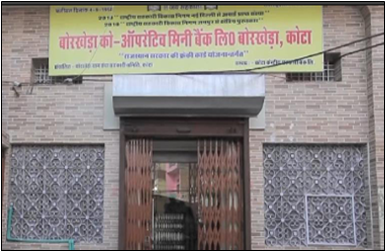
At present, India has more than 8.44 lakh cooperative societies spanning 30 sectors, including credit, housing, marketing, dairy, fisheries, and more—functioning as essential instruments for rural credit, self-employment, and collective economic strength.
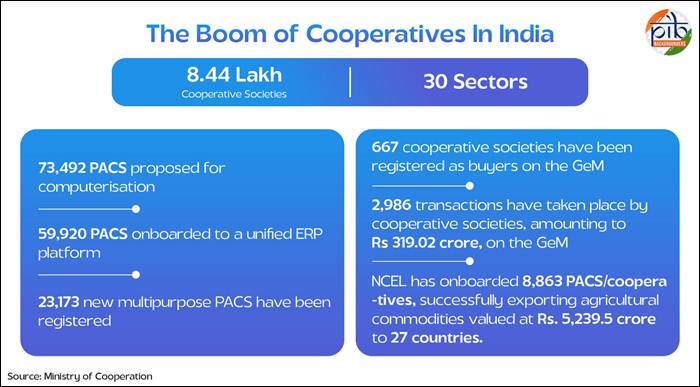
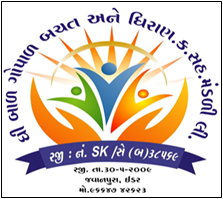
The momentum of growth is visible even among children in Gujarat. The Bal Gopal Savings and Credit Cooperative Society, based in Sabarkantha, is India’s only cooperative exclusively for children aged 0–18. Through this unique “Baal Bachat Sanskar” model, children are given saving boxes, and the amounts collected each month are deposited into their bank accounts at 6% annual interest. As of March 2024, 19,020 child members from 335 villages have saved ₹17.47 crore. The cooperative also extends self-guaranteed loan to the guardian of a member child and loan against property for child’s higher education. A total of 1,070 children's guardians have been given loans and a total of 5,370 children have been financially counselled.

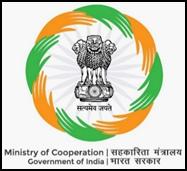
The wave of transformation began in 2021 with the creation of the Ministry of Cooperation. In just four years, it has launched 61 structured initiatives designed to modernise, digitise, and diversify cooperative societies. Among the most transformative have been sanctioning of the proposal for the computerisation of 73,492 Primary Agricultural Credit Societies (PACS), the onboarding of 59,920 PACS to a unified Enterprise Resource Planning (ERP) platform (as of July 22, 2025), and the formal rollout of multipurpose cooperative models under new by-laws.
In Tamil Nadu’s Villupuram district, the Arakandanallur PACCS offers a powerful example of digital preparedness. When devastating floods destroyed its physical infrastructure and paper records, the society’s prior adoption of PACS computerisation and cloud-based storage enabled swift recovery. Staff accessed member and transaction data remotely, and services resumed quickly, with minimal disruption. This case has since become a model for disaster-resilient cooperative design. Similar is the case of the Kharsai Vividha Karyakari Society in Maharashtra. Burdened earlier by inefficiencies and paper-based accounting, it adopted full-scale ERP systems under the PACS computerisation program. Since then, its performance has improved across all metrics—accuracy, transparency, speed, and member satisfaction. It now stands as a textbook case of how cooperatives can thrive in the digital age.
The government’s strategy also includes massive expansion. As of July 22, 2025, 23,173 new multipurpose PACS, dairy, and fisheries cooperatives have been registered. These PACS are being designed to handle grain storage, fertiliser and seed distribution, LPG and petrol pumps, and Jan Aushadhi Kendras, based on a single ERP-based digital architecture.
The vision is clear: one cooperative in every village, functioning as a multi-service hub.

The digital shift isn’t limited to finance. As of March 31, 2025, 667 cooperative societies have been registered as buyers on the Government e-Marketplace (GeM). Efforts are also being made to onboard cooperatives as sellers to boost rural artisans’ access to national markets. By March 31, 2025, 2,986 transactions have taken place by these cooperative societies, amounting to Rs 319.02 crore.
Moving from the digital to the sustainable, the Dhondi Solar Energy Producer Cooperative Society in Gujarat’s Kheda district is a notable example. Registered in collaboration with Tata Consulting and IWMI, it is India's first cooperative solar energy society. Solar panels have been installed in the fields of 9 out of 12 farmer-members to irrigate their land using solar power, and sell surplus energy to the state grid. In two years, they’ve earned ₹8 lakh through green energy, reducing dependence on diesel and promoting sustainable agriculture.
Cooperatives in India are increasingly serving as local community hubs, offering a unified platform for financial services, educational development, welfare schemes, healthcare access, and essential utilities—fostering inclusive development at the grassroots level. Stories from West Bengal further reinforce this nationwide momentum.
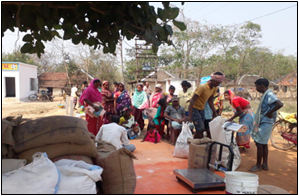
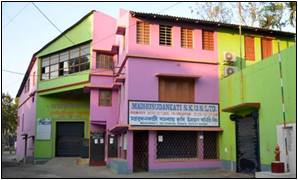
The Madhusudankati Agricultural Credit Society (SKUS) has gone from basic agri-credit to becoming a full-service multipurpose PACS. It extends Kisan Credit Card and Self-Help Group loans, operates as a retail and wholesale dealer of fertilisers and pesticides—including IFFCO and BENFED products. The Society also runs a Custom Hiring Centre, Rural Water Project, Agricultural Produce Procurement Centre, and consumer goods stores. In addition to its economic activities, it actively contributes to social welfare by organising health camps and operating a medical centre, children’s park, and community centre. Similarly, the Murakata Samabay Krishi Unnayan Samity (SKUS) began with 45 members and had grown to 1,603 members by 2022. Initially functioning as a non-deposit credit society, it now offers comprehensive banking services, including deposit facilities. The society provides Custom Hiring Centre services to local farmers at affordable rates. Covering mostly forested and inhabited by economically weaker sections, it primarily serves a farming-based community. Previously limited to single-crop cultivation, local farmers now benefit from increased access to KCC loans, crop insurance, and affordable harvesting services, enabling year-round cultivation.
In Jammu & Kashmir’s Poonch district, the Gold MPCS Limited stands out for its comprehensive rural services. It provides crop loans, insurance, PM Surya Ghar scheme facilitation, and acts as a Common Service Centre (CSC). In FY 2023–24, the CSC of this society completed 641 transactions, while in FY 2024–25 (till November 11, 2024), it recorded 1,852 transactions, reflecting its growing popularity and usefulness. In the last six months, transactions worth ₹9.16 lakh were carried out through the CSC—helping citizens with PAN card generation, insurance, and bill payments. Similarly, in Kishtwar (J&K), the Atholi Multipurpose Cooperative Society acts as a lifeline for the local community. Operating under model bylaws, the society runs a Jan Aushadhi Kendra and provides CSC services and nutritional supplies to Anganwadi centres. In FY 2024–25, its business turnover was ₹18.66 lakh, reflecting its growing commercial success and influence in the community.
India’s cooperative reforms have also taken shape at the national level. In 2023, three multi-state cooperatives were formed to give cooperatives access to markets, branding, and export capacity:
- National Cooperative Exports Limited (NCEL)
- National Cooperative Organics Limited (NCOL)
- Bharatiya Beej Sahakari Samiti Limited (BBSSL)
As of March 31, 2025, NCEL has already onboarded 8,863 PACS/cooperatives to facilitate collective exports. Further, NCEL has successfully exported approximately 13.08 LMT of agricultural commodities, including rice, wheat, maize, sugar, onion, and cumin seed, valued at Rs. 5,239.5 crore to 27 Countries. While, 5,185 PACS/ cooperative societies have become member of NCOL. NCOL has launched 21 products worth around Rs. 167.1 lakh under ‘Bharat Organics Brand’. NCOL has also signed Memorandums of Understanding (MoUs) with nodal agencies across 10 states. On the other hand, 19,171 PACS/ Cooperative Societies have become member of BBSSL. BBSSL has been granted a seed license in 13 states.
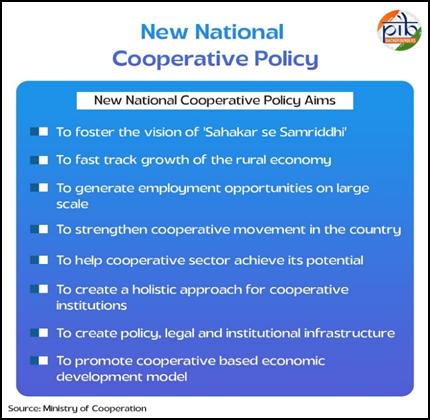
The Ministry has recently launched a New National Cooperative Policy on July 24, 2025, to further accelerate this transformation. The objective of the National Cooperative Policy is to make cooperative institutions inclusive, manage them professionally, prepare them for the future and be able to create large scale employment and livelihood opportunities especially in rural India. The new cooperative policy will prove to be a milestone in the cooperative movement of India for the next two decades from 2025-45.
The new policy will lay the roadmap for achieveing the vision of “Sahkar-se-Samriddhi” and contribute to India’s collective ambition of becoming “Atmanirbhar” and “Viksit” by 2047.
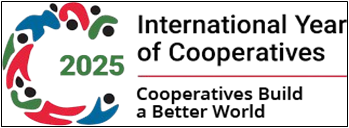
Further, as part of the International Year of Cooperatives (IYC) 2025 declared by the United Nations, the Ministry of Cooperation has launched a comprehensive National Action Plan to position Indian cooperatives on the global stage. The plan focuses on showcasing India's successful cooperative models—like AMUL, IFFCO and KRIBHCO—through international exhibitions, documentation of best practices, and digital outreach. The government is also working to promote cooperative exports, support startups within cooperatives, and facilitate cross-country learning. The initiative aims to make India a global hub for cooperative innovation by leveraging its grassroots strength and vast membership base.
Some Most Successful Cooperatives in India
|
Cooperative
|
Sector
|
Notable Achievement
|
|
AMUL (GCMMF)
|
Dairy
|
India's largest dairy cooperative; played a pivotal role in the "White Revolution" which helped India become the world’s largest milk producer; turnover above 7.3 billion.
|
|
IFFCO
|
Fertilizer
|
India's largest fertilizer cooperative and the world’s largest cooperative by GDP per capita; with revenue above 7.3 billion (FY23), its remarkable growth earned it a place in Fortune India 500 list.
|
|
Karnataka Milk Federation (Nandini)
|
Dairy
|
Second-largest dairy cooperative in India; operates with 15 milk unions across Karnataka, procuring milk from primary dairy coop societies; serves both urban and rural markets, benefiting over 1,500 members.
|
|
Indian Coffee House Society
|
Consumer/Restaurants
|
Managed by a network of worker cooperatives; approx. 400 coffee outlets.
|
|
Uralungal Labour Contract Cooperative Society
|
Labour Cooperative Society
|
Oldest labour cooperative society in India; With a membership of around 1415 individuals, ULCCS has successfully completed more than 7500 projects
|
India’s cooperative boom is no longer an abstract ideal—it is a grounded, grassroots revolution. Cooperatives are not just empowering people—they’re reimagining what inclusive, democratic growth can look like. What began as a people’s movement over a century ago may now be the key to India’s equitable and inclusive growth.
References
Ministry of Cooperation
Kurukshetra Magazine: July 2025 Edition (Page No. 22)
https://cooperatives.gov.in/en
https://www.cooperation.gov.in/en/2023-2024
https://x.com/MinOfCooperatn/status/1816337535905550687
https://www.pib.gov.in/PressReleasePage.aspx?PRID=2146772
https://www.cooperation.gov.in/en/major-initiative-of-the-ministry
https://vamnicom.gov.in/uploads/4f51e1ee3035ac8005355277540565be.pdf
https://vamnicom.gov.in/uploads/ebc76414f685d0ee399c9b8f993505d0.pdf
https://www.cooperation.gov.in/sites/default/files/2025-03/IYC%20Annual%20Action%20Plan-English.pdf
PM India
https://www.pmindia.gov.in/en/news_updates/pm-inaugurates-ica-global-cooperative-conference-2024/
Gujarat Government
https://rcs.gujarat.gov.in/Home/ICASS
Rajasthan Government
https://rajsahakar.rajasthan.gov.in/Content/SuccessStory/Borkheda_Village_Service_Cooperative_Society_Kota.pdf
West Bengal Government
https://cooperation.wb.gov.in/assets/pdf/Madhusudankati.pdf
https://cooperation.wb.gov.in/assets/pdf/Murakata-SKUS.pdf
Click here for pdf file
***
RT | SM
(Features ID: 154936)
Visitor Counter : 206
Read this release in:
Hindi